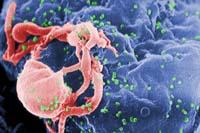25 years and more of AIDS
2008/05/24 Galarraga Aiestaran, Ana - Elhuyar Zientzia

25 years ago, on May 20, 1983, the scientific journal Science published an important work of researchers from the Pasteur Institute. This article revealed the identification of the virus causing AIDS. It was the human immunodeficiency virus, HIV.
Since then, the AIDS vaccine has been one of the main objectives of health research, but they have not achieved it. Meanwhile, the virus has infected 60 million people and killed 25 million. However, at the time when the virus was identified, predictions were not so pessimistic. For example, in 1984, the then US health officer announced that the AIDS vaccine was going to be in the testing phase in two years. It is clear that he was very wrong.
In these 25 years only two vaccines have reached the final phase of the tests, that is, to test in people, and the results have been discouraging. The latest trial has been funded by the pharmaceutical company Merck and the U.S. Department of Health. It began its development in 2004, being a recombinant virus that expressed three genes of the virus. After the first phases of clinical sessions and with good results in monkeys, it was time to test in people.
The researchers obtained volunteers and already incorporated infected and healthy people. The results, however, have been really negative: on the one hand, the vaccine has not decreased the number of viruses in the blood of people who were already infected and on the other, it has not prevented infection in healthy people. Moreover, it seems that some volunteers increased the risk of infection after vaccination.
The experiment has shown that researchers do not know enough about HIV or its interaction with human immune systems. However, they still hope to get AIDS protection through vaccines. In fact, some primates used in the research have obtained immunization with vaccines. In addition, in a few infected people, the virus has disappeared after treatment. At least with current detection methods they do not find viruses, and some have been around for 25 years. It seems that these few have managed to heal. In the rest, if they have the possibility of adequate treatment, AIDS becomes a chronic but incurable disease. And for those who do not receive treatment it is deadly.
According to the World Health Organization, if the vaccine is not obtained, AIDS will be the most serious disease by 2030. Other infectious diseases, such as malaria, diarrhoea and tuberculosis, are expected to be controlled, and although the most lethal is a heart disease, AIDS will be the cause of the greatest health problems.
Powerful virus

(Photo: CDC/C.Goldsmith)
However, researchers know it is very difficult to get the vaccine because of the characteristics of the virus itself. For starters, the AIDS virus, HIV, has many faces. Its mutation and combination capacity is enormous, which causes many genetic variants of the virus to be dispersed around the world.
Researchers have identified three large groups, M, N, and O, and group M, for example, is divided into 9 subgroups, with their combinations. Thus, in the body of a single infected person there are more types of HIV than types of influenza viruses that occur worldwide in a flu epidemic. Considering that there are 33 million people infected with HIV, the existence of so many variants of the virus greatly hinders the development of a vaccine that protects them from everything.
Another major obstacle is that it infects the cells of the immune system. The function of these cells is to protect the body from aggressors, so HIV leaves the body unable to fight infection. In addition, the virus has evolved to escape immune system strategies. It has also found shelter: the virus incorporates its genetic material to the lymphocyte chromosome, which allows the infected person to take the hardest medicines, but the virus can always reproduce. Therefore, the fact that the vaccine is not able to protect it from a lot of variants should be achieved quickly before HIV stores the genetic material in hiding.
For all this, the recent publication of the journal Science has shown that researchers believe that we must go back in research to get the vaccine and try to know the virus better. And for this they ask that the money be allocated. They recognize the need to better understand not only the virus, but also the functioning of the immune system and vaccines. In fact, although the first vaccine was achieved in 1796, and since then numerous effective vaccines have been made, they still do not know perfectly how they get the body protected.
However, there are experts in Africa who disagree, do not believe that is the priority. According to them, AIDS mortality worldwide is 3.7%, but it receives 25% of health subsidies. They therefore consider that money should be used to compensate for the existing health imbalance between countries. For them AIDS is a serious problem, very serious, but not the worst.
Published in Gara

Gai honi buruzko eduki gehiago
Elhuyarrek garatutako teknologia




